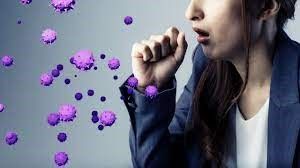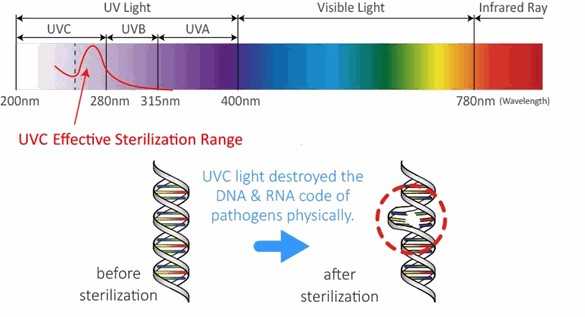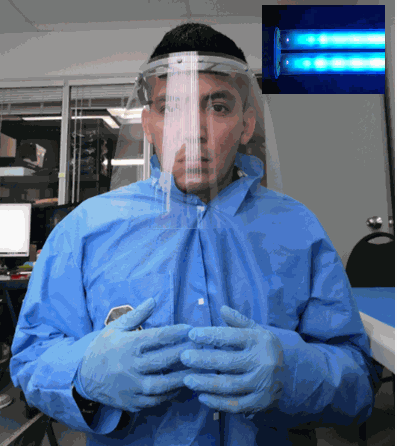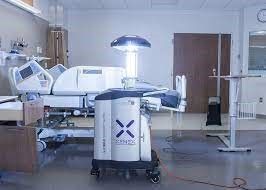In this article, various arc lamp based ultraviolet technologies that are used for inactivation of pathogens such as viruses and bacteria are examined. Particular emphasis is given to SARS-CoV-2 virus. The SARS-CoV-2 virus which originated in Wuhan China has spread very rapidly throughout the world and since March 2020, the World Health Organization has declared it a pandemic. There has been over 150 million confirmed cases and more than 3 million deaths due to this virus as of May 2021. Although SARS-CoV-2 is zoonotic by nature, it can be spread through human to human contact. Droplets generated by an infected person which are suspended in the air due to coughing, sneezing, exhaling and talking could be inhaled by other persons and infect them. The virus can survive on surfaces such as plastic and steel for 72 hours and on cardboard for 24 hours. Although vaccinations are underway, there is a need for a technology to inactivate the virus on contaminated surfaces. Figure 1 shows the shedding of droplets containing the virus by an infected person.

Figure 1: Shedding of droplets containing the virus by an infected person
Given the rapid transmission of the SARS-CoV-2 virus and the long schedule required to vaccinate the whole population, it is required to utilize an effective technology to disinfect the surfaces as much as possible. Hospital rooms occupied by infected patients and public transits are places where high concentrations of the virus can be found.
Although the use of
chemical disinfectants and alcohols are recommended for in activating the SARS-CoV-2
virus, the disinfection of large areas infected by the virus is a laborious
process that requires direct contact with the surfaces and therefore these
methods are not efficient. The UVC technology which occupies the 200-280 nm region
of the UV spectrum has been used for virus and bacteria disinfection for many
years. It is definitely less laborious than cleaning with chemicals and does
not require close contact with the
contaminated surfaces. Figure 2 shows the action spectrum of the virus
superposed on the UVC spectrum.

Figure 2: The action spectrum of tne virus is superposed on the UV spectrum
As can be seen in figure 2, the peak of the germicidal action spectrum is at 265 nm and any radiation in the UVC range of 250-280 nm could be highly effective in killing the pathogens. The tail of the germicidal action spectrum also extends in the UVB region. The UVC radiation destroys the DNA and RNA code of the pathogens and photochemical damage to the DNA and RNA of the virus disrupts its replications.
We now examine three discharge based UVC lamp technologies and their effectiveness in disinfecting the SARS-CoV-2 virus.
The first arc discharge lamp that is discussed is the well-known mercury arc lamp that has its main emission spectral line at 254 nm. Inactivation of the virus in both wet and dry formats is possible by using this lamp1. The photochemical damage inflicted by this radiation to the nucleic acid of the virus disrupts its viral replication1. In one study1 the SARS-CoV-2 virus was applied to plastic tissue culture dishes in both wet and dry formats and UVC radiation at 254 nm of irradiance 0.849 mW/cm^2 was applied at varying times ranging from 0.8 to 120 seconds. The study found that for 0.8 second exposure, only partial inactivation of the virus was achieved while complete inactivation (Below the detection level) was achieved with 9 seconds of exposure for the dried virus and 4 seconds for the wet virus. It is to be noted that this study was performed in the lab environment under controlled conditions. In a real world scenario, humidity, presence of textured surfaces, and aerosols may alter the effectiveness of this radiation for inactivation of SARS-CoV-2. It is also to be noted that the composition of respiratory droplets in real scenarios could be different than the lab conditions. There may be other droplets such as mucus which may also absorb UVC radiation and reduce the effectiveness of this radiation for inactivation of SARS-CoV-2. Finally it is important to mention that the 254 nm radiation is hazardous to eyes and skin and therefore the lamp should be turned on only when the location is empty of people or if there are people present while the lamp is on, they need to protect their eyes using normal glass and the exposed skin using thick fabric. An example for the proper eye and skin protection is shown in figure 3.

Figure 3: Protection of eyes and exposed skin against 254 nm UVC radiation
The second arc discharge lamp that is discussed is the excimer lamp with a far UVC radiation of 207-222 nm2. Although the germicidal effectiveness of this range of radiation is reduced with respect to the peak wavelength of the action spectrum of 265 nm (and also compared to the 254 nm radiation from the conventional mercury lamp), using the excimer lamp makes it possible to disinfect in public places with no protection. The reason is that the radiation of this range has a very small penetration depth of the order of a few microns and is very strongly absorbed by protein through peptide bonds and other molecules. Therefore the radiation can not penetrate deep into the skin or eyes because it is absorbed by the dead-cell outer layers and cannot damage live cells deep within the skin or eyes2. Several researchers have proposed the usage of this radiation in place of conventional mercury lamps and studies have shown that this radiation could disinfect the surfaces from SARS-CoV-2 or similar viruses of beta genome as well2. Figure 4 shows a far UVC lamp with a 222 nm emission.

Figure 4: Far UVC lamp with emission at 222 nm. This particular lamp was manufactured by the company Ushio3
The final lamp technology that is discussed in this article is the pulsed xenon lamp that emits a broadband radiation from 200-700 nm4. Studies have shown that pulsed radiation significantly out-performs CW radiation in disinfecting liquid solutions and also surfaces5. Obviously this broadband radiation that contains UVC, UVB, UVA and visible light is still dangerous for the eyes and the skin and proper protection against it is needed. A study4 has shown that broad spectrum pulsed UV radiation is effective in inactivating SARS-CoV-2 on multiple surfaces outside of the living organism. The broadband UV device used in the study4 consisted of two high energy xenon lamps which produced broadband UV-VIS spectrum in the range 200-700 nm. When activated, the device produced a 2 ms pulse every 6 seconds for a period of up to 30 minutes. The lamp was placed at the center of a biosafety cabinet and the infected surface was 1 meter away from the lamp. The result of the testing was as follows:
· For hard, nonporous surfaces such as glass and plastic, an exposure of 5 minutes (17.2 mj/cm2 dosage) was sufficient to achieve 3 log 10 reduction in infectious virus retrieved from the surfaces.
· A 10 minute exposure (34.9 mj/cm2 dosage) was enough to reduce the infectious virus to undetectable limits for glass and plastic while for stainless steel a 15 minute exposure (52.5 mj/cm2) was required to have the same effect.
· For N95 masks a 30 minute exposure (103 mj/cm2 dosage) was needed to reduce the virus to undetectable levels.
Figure 5 shows a broadband xenon lamp in action in a hospital room.

Figure 5: Pulsed xenon lamp disinfecting a hospital room
References:
1- Rapid and complete inactivation of SARS-CoV-2 by ultraviolet-C irradiation, N.Strom et.al, Scientific reports, (2020) 10:22421
2- Far-UVC light (222 nm) efficiently and safely inactivates airborne human coronaviruses, M.Buonanno et.al, Scientific reports, (2020) 10:10285
4- Pulsed broad-spectrum UV light effectively inactivates SARS-CoV-2 on multiple surfaces and N95 material, A.S. Jureka et.al, Viruses 2021, 13, 460
5- A comparison of pulsed vs. continuous ultraviolet light sources for the decontamination of surfaces, K.McDonald et.al, IEEE Xplore (2002)